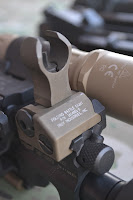With all of this talk about the
competition rifle, lets take a break and look at some pistols.
In my opinion we have several classes
as pistols.
- Tactical
- Practical
- Modified
- Concealed Carry
- Open Carry
- Competition
- Precision shooting
Tactical
Lets start with tactical. “Practical”
is the idea of the general issue pistol. I was issued the M9 as a
soldier. With the high safety it makes accidents more difficult as
well as takes more time to get the weapon into action.
As a competitor in Hawaii I used the
Beretta 96 as my competition pistol due to being issued the M9. The
M9 (92) and 96 are very similar pistols, almost identical except for
caliber. The 96 is a 40 caliber and the 92 is a 9mm. The 40 caliber
had a better “power factor” as was able to take down the steel
targets where the 9mm would not.
Since it was the same pistol overall it
would not change my “muscle memory” and in a combat situation I
would not make a critical error.
Now, I don't do anything simple when it
comes to my firearms. The FNP-45 Tactical has a threaded barrel,
rail for lights or laser (or combo of both). I am still waiting on
the ATF to return my tax stamp for the Gemtech Blackside suppressor
that I purchased last year. When it arrives I will be able to
suppress the sound and the flash. Shown in the picture is a
Streamlight flashlight.
Concealed Carry
There are a lot of things here to talk
about. Size matters is one them. Insert Joke Here.....
There are many pistols on the market
that are made to conceal and finding the one that fits you is what
matters. This is assuming you are buying a quality firearm.
.380 is a popular round, but I am not a
fan. Most 380 caliber pistols are really, really small but that does
not help help recoil. Too small of a pistol and the recoil is not
managed well. Too large of a pistol for a small caliber and you
loose the benefit of the of the small ammo (concealment).
 |
| Springfield V10 Ultra Compact and G26 (Shown with optional Magpul floor plate) |
The small frame 1911 format is a great
choice. Seven rounds of .45 in a pistol that you conceal easily is a
good choice to have if you need it. The ten rounds of 9mm in my
Glock 26 is also a good choice. The right ammo is always a factor no
matter what you carry. One of the benefits to both of the above is
that you do not have to relearn what you know. Using a small frame
1911 feels the same as the bigger version as does the Glock 26. You
do lose some accuracy with the smaller barrels, but these are self
defense weapons and not competition models.
Open Carry
Why? All you do is let the bad guys
know you are their biggest threat and should be taken out first.
If you choose to carry, and can legally
do it where you live, conceal it. If you carry so you can tell the
world that you are a “big boy” then go back to playing your video
games and telling 12 year old kids online that you are a bad ass.
Competition
This is a world of its own. Normally I
shoot competitions with a 1911A1 (Kimber Desert Warrior). The 1911
Frame is great for competition due to the weight and balance.
 |
| Kimber Desert Warrior with ten round magazine. |
Most matches I shoot in limit the
magazine capacity to 10 rounds so having ten .45 caliber or ten 9mm
rounds doesn't make a difference, you get no real advantage with
higher capacity rounds and the .45 always takes the steel down as
long as you hit it.
The Glock G34 is my Glock choice. A
longer barrel, better balance and the perfect grip for my hand makes
the G34 perfect for me. After market parts make this pistol very
easy to upgrade, when competition is judged to tenths of a second,
speed matters.
 |
| G34, Trijicon Night Sights. Optional Magpul Floor plate |
Precision Shooting
This all about hitting the 10. Its all
about shot groups. The better the shooting, the better the score,
usually shot from a bench or standing, just depends on the match
rules.
The Ruger 10/22 is my competition .22.
Simple and accurate. The bipod provides a stable platform when
benched, with out it the grip is perfectly balanced.




















.JPG)
.JPG)


.JPG)

